I have a disparity image created with a calibrated stereo camera pair and opencv. It looks good, and my calibration data is good.
I need to calculate the real world distance at a pixel.
From other questions on stackoverflow, i see that the approach is:
depth = baseline * focal / disparity
Using the function:
setMouseCallback("disparity", onMouse, &disp);
static void onMouse(int event, int x, int y, int flags, void* param)
{
cv::Mat &xyz = *((cv::Mat*)param); //cast and deref the param
if (event == cv::EVENT_LBUTTONDOWN)
{
unsigned int val = xyz.at<uchar>(y, x);
double depth = (camera_matrixL.at<float>(0, 0)*T.at<float>(0, 0)) / val;
cout << "x= " << x << " y= " << y << " val= " << val << " distance: " << depth<< endl;
}
}
I click on a point that i have measured to be 3 meters away from the stereo camera. What i get is:
val= 31 distance: 0.590693
The depth mat values are between 0 and 255, the depth mat is of type 0, or CV_8UC1.
The stereo baseline is 0.0643654 (in meters).
The focal length is 284.493
I have also tried: (from OpenCV - compute real distance from disparity map)
float fMaxDistance = static_cast<float>((1. / T.at<float>(0, 0) * camera_matrixL.at<float>(0, 0)));
//outputDisparityValue is single 16-bit value from disparityMap
float fDisparity = val / (float)cv::StereoMatcher::DISP_SCALE;
float fDistance = fMaxDistance / fDisparity;
which gives me a (closer to truth, if we assume mm units) distance of val= 31 distance: 2281.27
But is still incorrect.
Which of these approaches is correct? And where am i going wrong?
Left, Right, Depth map. (EDIT: this depth map is from a different pair of images)

EDIT: Based on an answer, i am trying this:
`std::vector pointcloud;
float fx = 284.492615;
float fy = 285.683197;
float cx = 424;// 425.807709;
float cy = 400;// 395.494293;
cv::Mat Q = cv::Mat(4,4, CV_32F);
Q.at<float>(0, 0) = 1.0;
Q.at<float>(0, 1) = 0.0;
Q.at<float>(0, 2) = 0.0;
Q.at<float>(0, 3) = -cx; //cx
Q.at<float>(1, 0) = 0.0;
Q.at<float>(1, 1) = 1.0;
Q.at<float>(1, 2) = 0.0;
Q.at<float>(1, 3) = -cy; //cy
Q.at<float>(2, 0) = 0.0;
Q.at<float>(2, 1) = 0.0;
Q.at<float>(2, 2) = 0.0;
Q.at<float>(2, 3) = -fx; //Focal
Q.at<float>(3, 0) = 0.0;
Q.at<float>(3, 1) = 0.0;
Q.at<float>(3, 2) = -1.0 / 6; //1.0/BaseLine
Q.at<float>(3, 3) = 0.0; //cx - cx'
//
cv::Mat XYZcv(depth_image.size(), CV_32FC3);
reprojectImageTo3D(depth_image, XYZcv, Q, false, CV_32F);
for (int y = 0; y < XYZcv.rows; y++)
{
for (int x = 0; x < XYZcv.cols; x++)
{
cv::Point3f pointOcv = XYZcv.at<cv::Point3f>(y, x);
Eigen::Vector4d pointEigen(0, 0, 0, left.at<uchar>(y, x) / 255.0);
pointEigen[0] = pointOcv.x;
pointEigen[1] = pointOcv.y;
pointEigen[2] = pointOcv.z;
pointcloud.push_back(pointEigen);
}
}`
And that gives me a cloud.